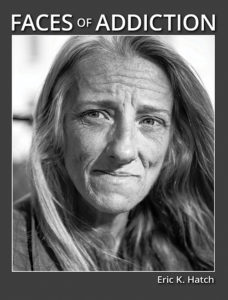Faces of Addiction
Reviewed by Carl Blumenthal
June 1, 2020
 By Eric K. Hatch. Barclay Press, 2019. 113 pages. $24.95/paperback. Order at facesofaddiction.net.
By Eric K. Hatch. Barclay Press, 2019. 113 pages. $24.95/paperback. Order at facesofaddiction.net.
Born under a bad sign,
Been down since I began to crawl.
If it wasn’t for bad luck,
I wouldn’t have no luck at all.
—Albert King, “Born Under a Bad Sign” (1967)
“We all have secrets,” my therapist tells me every time I spill my guts. Mental illness and substance abuse run in my family, but not so deep that I’m drowning. My wife, f/Friends, and bankroll keep me afloat.
The 52 people affected by drug addiction who Eric Hatch profiles in Faces of Addiction are short on such lifelines. They’re so entangled in poverty, violence, crime, family discord, homelessness, scanty education, and meager healthcare, it’s a miracle they have the strength to pose for photos and bare their souls.
“You ought to be out shooting [pictures of] drug addicts.” That’s what a Quaker mother whose son died of an opioid overdose told Hatch, a member of Cincinnati (Ohio) Meeting, at a New Year’s party in 2018. A landscape and architecture photographer, he demurred, but later on a long drive, “Somewhere between the towns of Boredom and Ennui, I had an insight, or as Quakers put it, a leading. Perhaps photographing addicts wasn’t a bad idea. It would certainly stretch my photographic skills.”
The way that opened was through Hamilton, Ohio, 20 miles north of Cincinnati, where most of Hatch’s subjects live. In 2017, the state was second only to West Virginia in opioid overdose death rates.
The result of Hatch’s effort is like a yearbook from a school of hard knocks but with dignified portraits, “not shock shots or street photography.” His expression of empathy and respect may be why Governor Mike DeWine displays a copy of Faces of Addiction in his office’s waiting room.
On each left-hand page are the name, age, type of addiction (heroin, meth, cocaine, alcohol, pills), status (using or in recovery), and bio of the individual. On the right is a full-page, head and shoulders image in black and white.
The mix of poses and camera angles as you leaf through the book keeps the display “moving.” As does the even split between men and women, though they’re all White, except for three African American men. (“Crack may have been an urban problem primarily among blacks, but in Southwest Ohio and Northern Kentucky today, opioids are largely a white problem.”)
This group is full of individuals who have suffered in extreme ways, such as Lisa Stewart, homeless since 2013; Brandi Bowman, a prostitute for 11 years; Mike Williams, in prison for 25 of his 45 years; Layne McWhorter, who started on pot at age six; Robin Jean Elmore, 48, addicted to crack for half her life; Timothy Ferris, cheated by his siblings out of $3 million; Amy Carreazo, with a $500-per-day habit; Jason Osborne, rehabbed 13 times in six years; and Michelle Roach, diagnosed with ten mental illnesses.
More than halfway through the book, I despaired that anyone would get better. Then, Billee Simpson, revived after an overdose, makes a shaky recovery. “She found participation in Faces of Addiction uplifting and became an active recruiter of other portrait volunteers.” Perhaps that’s why Billee, with her dirty blond tresses, is the book’s “cover girl.”
From there the success stories multiply: 20 of the addicts have been clean for days, weeks, months, and even years with the help of treatment, support groups, social services, hobbies, jobs, and/or God. But as one of them, Ashley Perrin, warns, “I have seen people clean 22 years, who suddenly relapse, and die, and that’s how insidious it is.”
Other words of wisdom come from Brian Kirk: “It’s funny. On speed you move very fast, but you don’t get shit done”; Thomas D.: “I’m addicted to not just being sober, really”; Timothy Childs: “With ice [meth], I can keep my job, pay my rent, buy food. Around here we call it ice skating”; Bill Harrison: “I found God and I didn’t lose Him when they let me out”; and Trevor Steinhauser: “Telling my story is what helps me keep sober.”
Faces of Addiction is now a nonprofit (facesofaddiction.net) with the two-fold goal of sharing the stories with then educating 500,000 people on how to prevent and reduce addiction. Creating a new sense of family among users who want to kick the habit and people who support their efforts is a key part of Hatch’s ministry.
As Hatch told me, “I found myself caring about these folks in ways I didn’t expect, and when I hear from them, which I do from time to time, I’m always thrilled to hear how they are doing. It’s like having a crop of 50 nephews and nieces, or grandchildren. You’re engaged with them, but definitely don’t run their lives!”
In “Supporting Recovery among Friends” (FJ Jan.), Friend Johanna Jackson says that the Quaker practice of “accompanying someone means staying nearby, through the pain and shame and fear, and holding fast to love from Spirit.” Faces of Addiction creates such a virtual “covenant community.”



Comments on Friendsjournal.org may be used in the Forum of the print magazine and may be edited for length and clarity.